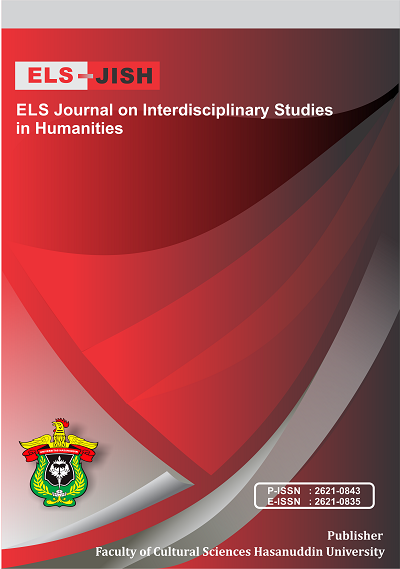The Reception Analysis in Ernest Hemingway’s Hills Like White Elephants
DOI:
https://doi.org/10.34050/elsjish.v7i1.32795Keywords:
Hills Like White Elephants, Moral Value, Reader's responseAbstract
This study is aimed to know the reader response toward “Hills Like White Elephants” by Ernest Hemingway. To limit the scope of the study, the analysis focused on reader’s response consist of intellectual aspect and emotional aspect and also moral value toward this short story. The readers are 20 students from English Department, Faculty of Cultural Sciences, Hasanuddin University. The method used is descriptive quantitative. Readers are given the opportunity to read Ernest’s short story, then answer a questionnaire consisting of agree and disagree question about the idea and emotions after reading the story itself. There are 20 respondents from English Department students, Faculty of Cultural Sciences, Hasanuddin University. The results of this study indicate that, in responding to Hills Like White Elephants short stories, readers can respond from two aspects namely, intellectual and emotional aspect, each of which consists of five aspects. Reader's response to short stories has differences both in terms of intellectual and emotional. The most positive response in intellectual are languange 90%, and the most negative response in intellectual aspect are theme 45%. In the other hand the most positive response in emotional aspect are emotion 75% and interest 75%. There are some moral value describes by readers including, thinking before acting, loving yourself, respecting others, life is a choice, a mother's love for all time, and honesty.
References
Andini, C. (2017). Children Emotion in The Movie" Big Hero 6. (Doctoral dissertation, Doctoral dissertation, Universitas Islam Negeri Alauddin Makassar).
Attridge, D. (2021). JM Coetzee and the Ethics of Reading: Literature in the Event. University of Chicago Press.
Boudjerida, M. (2019). Implication and Omission in Ernest Hemingway’s “Hills Like White Elephants,” Raymond Carver’s “Why Don’t you Dance,” Richard Ford’s “Great Falls,” and Bobbie Ann Mason’s “Shiloh”. الخطاب, 14(1), 659-678.
Kaowiwattanakul, S. (2021). CEFR Based Learning Approach: Using Literature to Enhance EFL Students' Reading Skills and Critical Thinking Skills. English Language Teaching, 14(11), 66-79.
Junaid, S., Ahmad, Mujizat, A., & Andini, C. (2023). The Quality of Human and Non-Human Relation in Indonesia and England Portrayed in the Selected Picture Books. ELS Journal on Interdisciplinary Studies in Humanities, 6(2), 211-218.
Junaid, S., Muzzammil, A., Mujizat, A., & Andini, C. (2023). Onomatopoeia Variation Among Cultures: An Exploration in Selected Children’s Story Books. ELS Journal on Interdisciplinary Studies in Humanities, 6(4), 658-664.
Kävrestad, J., Fallatah, W., & Furnell, S. (2023). Cybersecurity training acceptance: A literature review. In International symposium on human aspects of information security and assurance (pp. 53-63). Cham: Springer Nature Switzerland.
Lewisch, L., & Riefler, P. (2023). Cultured meat acceptance for global food security: a systematic literature review and future research directions. Agricultural and Food Economics, 11(1), 48.
Meckley, E. (2018). What's in a Name? Racial Transparency and the Jazz-Age in Hemingway's" Hills Like White Elephants". The Hemingway Review, 38(1), 57-70.
Nahdhiyah, N., Rahman, F., Makkah, M., & Herawaty, H. (2022, February). The Role of Learning Literary Work in Enhancing the Awareness of Loving Nature. In 67th TEFLIN International Virtual Conference & the 9th ICOELT 2021 (TEFLIN ICOELT 2021) (pp. 296-301). Atlantis Press.
Nielsen, J. A., Stavrianakis, K., & Morrison, Z. (2022). Community acceptance and social impacts of carbon capture, utilization and storage projects: A systematic meta-narrative literature review. PLoS one, 17(8), e0272409.
Rahman, F. (2016). The Strategy of Teaching Literature through Language-based Methods: A Communicative Approach. In Annual Seminar on English Language Studies (Vol. 1, pp. 156-170).
Rahman, F. (2017). Cyber literature: A reader–writer interactivity. International Journal of Social Sciences & Educational Studies, 3(4), 156.
Rahman, F. (2018). Literature of the Minority in South Sulawesi Endangered. Medwell Journals Medwell Publications, 13(14), 820-825.
Sahib, H., & Rahman, F. (2021). Dialogic Speech in Marriage Proposal of Konjonese. In The 2nd International Conference of Linguistics and Culture (ICLC-2) (pp. 105-110). Atlantis Press.
Sinha, K. K. (2021). The Role of Pragmatics in Literary Analysis: Approaching Literary Meaning from a Linguistic Perspective. International Journal of English and Comparative Literary Studies, 2(2), 29-40.
Sugianto, I., Suryandari, S., & Age, L. D. (2020). Efektivitas model pembelajaran inkuiri terhadap kemandirian belajar siswa di rumah. Jurnal Inovasi Penelitian, 1(3), 159-170.
Suma, M., Rahman, F., Dalyan, M., Rahman, F. F., & Andini, C. (2023). Literature And Family Development: A Character Building Education. Journal of Namibian Studies: History Politics Culture, 39, 220-232.
Wijnen, F., Walma van der Molen, J., & Voogt, J. (2023). Primary school teachers’ attitudes toward technology use and stimulating higher-order thinking in students: A review of the literature. Journal of research on technology in education, 55(4), 545-567.
Wilson, R. (2021). HPV vaccine acceptance in West Africa: a systematic literature review. Vaccine, 39(37), 5277-5284.
Downloads
Published
Issue
Section
License
Copyright (c) 2024 Andi Sarwindah, Abidin Pammu, Andi Inayah Soraya

This work is licensed under a Creative Commons Attribution-ShareAlike 4.0 International License.






